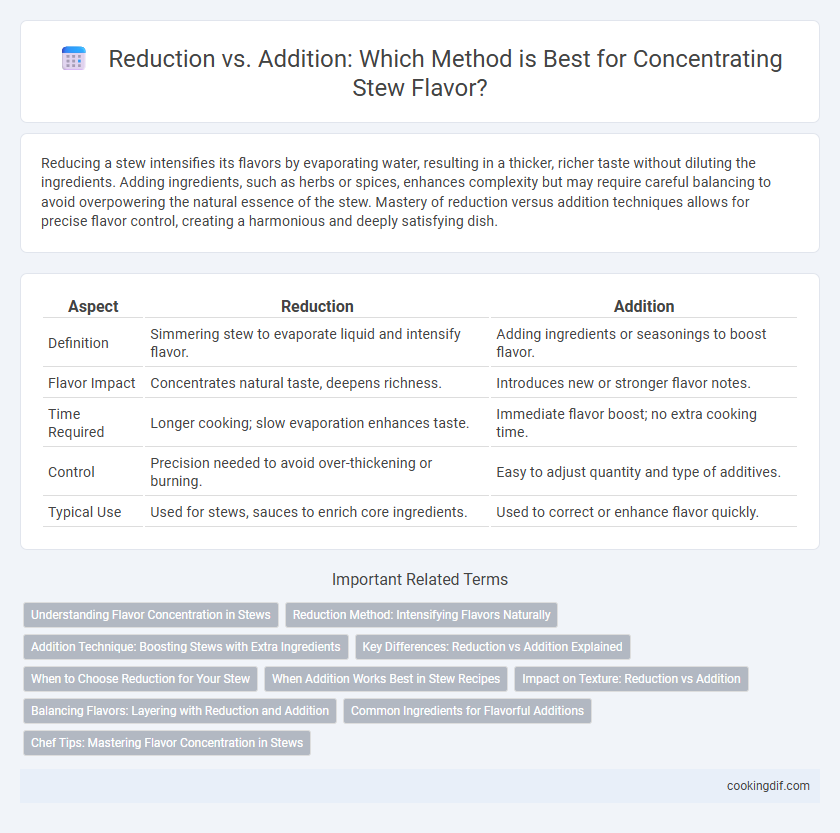Reducing a stew intensifies its flavors by evaporating water, resulting in a thicker, richer taste without diluting the ingredients. Adding ingredients, such as herbs or spices, enhances complexity but may require careful balancing to avoid overpowering the natural essence of the stew. Mastery of reduction versus addition techniques allows for precise flavor control, creating a harmonious and deeply satisfying dish.
Table of Comparison
| Aspect | Reduction | Addition |
|---|---|---|
| Definition | Simmering stew to evaporate liquid and intensify flavor. | Adding ingredients or seasonings to boost flavor. |
| Flavor Impact | Concentrates natural taste, deepens richness. | Introduces new or stronger flavor notes. |
| Time Required | Longer cooking; slow evaporation enhances taste. | Immediate flavor boost; no extra cooking time. |
| Control | Precision needed to avoid over-thickening or burning. | Easy to adjust quantity and type of additives. |
| Typical Use | Used for stews, sauces to enrich core ingredients. | Used to correct or enhance flavor quickly. |
Understanding Flavor Concentration in Stews
Flavor concentration in stews is achieved primarily through reduction, where simmering the liquid evaporates water, intensifying the taste and richness of the broth. Addition involves introducing concentrated ingredients such as stock, spices, or umami-rich components, which enhance complexity without altering the stew's volume significantly. Mastering the balance between reduction and addition ensures a stew with a deep, harmonious flavor profile that highlights both freshness and depth.
Reduction Method: Intensifying Flavors Naturally
Reduction method in stew involves simmering the liquid over low heat to evaporate water content, intensifying the natural flavors of ingredients like meat, vegetables, and herbs. This technique enhances the stew's richness and depth without the need for additional seasonings or artificial additives. By concentrating the existing flavors, reduction achieves a robust and savory profile that highlights the stew's original components.
Addition Technique: Boosting Stews with Extra Ingredients
Boosting stews with the addition technique involves incorporating concentrated flavor ingredients such as tomato paste, soy sauce, or stock cubes to intensify the overall taste without lengthy cooking. Herbs like rosemary, thyme, and bay leaves enhance aromatic complexity while vegetables like roasted garlic and caramelized onions add depth and sweetness. This method preserves the stew's volume and texture while elevating its richness and flavor layering effectively.
Key Differences: Reduction vs Addition Explained
Reduction intensifies stew flavor by simmering to evaporate water, concentrating existing ingredients' taste and thickening the sauce naturally. Addition involves incorporating extra seasoning or ingredients to enhance flavor, allowing customization but not changing the stew's base intensity. Key differences lie in reduction's ability to deepen and unify flavors through evaporation versus addition's role in adjusting and layering flavors without altering volume significantly.
When to Choose Reduction for Your Stew
Reduction intensifies stew flavors by simmering the liquid to concentrate taste and thicken the texture, ideal when the broth is too thin or mild. Choose reduction when you want to deepen savory notes from ingredients like beef, herbs, and wine, creating a robust, rich profile. Avoid adding more ingredients when the stew already contains balanced components; instead, reduce the liquid to enhance umami and aromatic complexity.
When Addition Works Best in Stew Recipes
When addition works best in stew recipes, it is typically during the final stages of cooking, where adding fresh herbs, spices, or acidic ingredients like lemon juice or vinegar can brighten and enhance the overall flavor profile. This technique is ideal for preserving delicate flavors and achieving a balanced taste without over-concentrating the stew. Using additions strategically prevents bitterness and allows for customization based on personal preference or specific ingredient combinations.
Impact on Texture: Reduction vs Addition
Reduction intensifies stew flavor by simmering to evaporate liquid, concentrating taste while thickening the texture and creating a rich, velvety mouthfeel. Addition techniques, such as incorporating broth or cream, dilute seasoning but can enhance stew's creaminess and tenderness, softening tougher meat fibers and balancing texture. Optimal stew texture results from balancing reduction's thickening effect with addition's softening properties to achieve depth and smooth consistency.
Balancing Flavors: Layering with Reduction and Addition
Reduction intensifies stew flavors by evaporating liquids, concentrating natural essences and enhancing depth without overpowering. Addition incorporates ingredients like herbs, spices, or broth to introduce fresh notes, balancing richness and complexity. Strategic layering of reduction and addition achieves a harmonious stew with nuanced, well-rounded taste profiles.
Common Ingredients for Flavorful Additions
Reduction intensifies stew flavor by evaporating excess liquid, concentrating spices, and enhancing natural meat and vegetable tastes. Common flavorful additions include garlic, thyme, bay leaves, and carrots, which deepen aroma and richness without overwhelming the dish. Incorporating red wine or tomato paste adds complexity, balancing the savory profile through layered tastes.
Chef Tips: Mastering Flavor Concentration in Stews
Reducing a stew by simmering gently intensifies flavors through evaporation, concentrating savory compounds and enhancing richness. Adding ingredients like herbs, spices, or umami-rich elements such as soy sauce or mushrooms deepens complexity without diluting the base flavors. Chefs recommend balancing reduction and addition to achieve a robust, layered taste profile that elevates the stew's overall character.
Reduction vs Addition for flavor concentration Infographic

 cookingdif.com
cookingdif.com